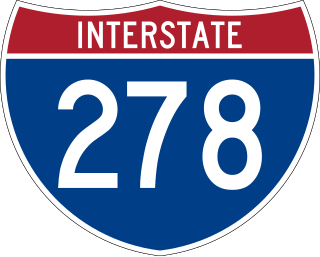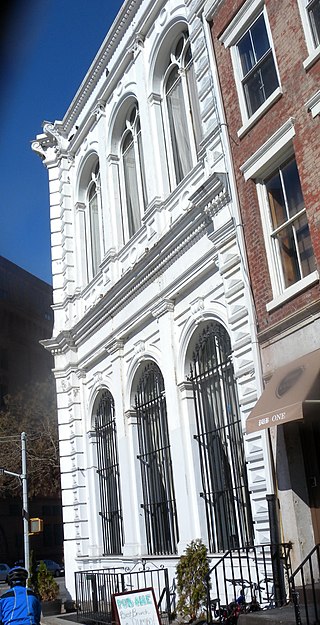
The Brooklyn Bridge is a hybrid cable-stayed/suspension bridge in New York City, spanning the East River between the boroughs of Manhattan and Brooklyn. Opened on May 24, 1883, the Brooklyn Bridge was the first fixed crossing of the East River. It was also the longest suspension bridge in the world at the time of its opening, with a main span of 1,595.5 feet (486.3 m) and a deck 127 ft (38.7 m) above Mean High Water. The span was originally called the New York and Brooklyn Bridge or the East River Bridge but was officially renamed the Brooklyn Bridge in 1915.

Site-specific art is artwork created to exist in a certain place. Typically, the artist takes the location into account while planning and creating the artwork. Site-specific art is produced both by commercial artists, and independently, and can include some instances of work such as sculpture, stencil graffiti, rock balancing, and other art forms. Installations can be in urban areas, remote natural settings, or underwater.

Interstate 278 (I-278) is an auxiliary Interstate Highway in New Jersey and New York in the United States. The road runs 35.62 miles (57.32 km) from US Route 1/9 (US 1/9) in Linden, New Jersey, northeast to the Bruckner Interchange in the New York City borough of the Bronx. The majority of I-278 is in New York City, where it serves as a partial beltway and passes through all five of the city's boroughs. I-278 follows several freeways, including the Union Freeway in Union County, New Jersey; the Staten Island Expressway (SIE) across Staten Island; the Gowanus Expressway in southern Brooklyn; the Brooklyn–Queens Expressway (BQE) across Northern Brooklyn and Queens; a small part of the Grand Central Parkway in Queens; and a part of the Bruckner Expressway in the Bronx. I-278 also crosses multiple bridges, including the Goethals, Verrazzano-Narrows, Kosciuszko, and Robert F. Kennedy bridges.

Dumbo is a neighborhood in the New York City borough of Brooklyn. It encompasses two sections: one situated between the Manhattan and Brooklyn Bridges, which connect Brooklyn to Manhattan across the East River, and another extending eastward from the Manhattan Bridge to the Vinegar Hill area. The neighborhood is bounded by Brooklyn Bridge Park to the north, the Brooklyn Bridge to the west, Brooklyn Heights to the south, and Vinegar Hill to the east. Dumbo is part of Brooklyn Community Board 2.

Fulton Ferry is a small area adjacent to Dumbo in the New York City borough of Brooklyn. The neighborhood is named for the Fulton Ferry, a prominent ferry line that crossed the East River between Manhattan and Brooklyn, and is also the name of the ferry slip on the Brooklyn side. The neighborhood is part of Brooklyn Community District 2.

The transportation system of New York City is a network of complex infrastructural systems. New York City, being the most populous city in the United States, has a transportation system which includes one of the largest and busiest subway systems in the world; the world's first mechanically ventilated vehicular tunnel; and an aerial tramway. New York City is home to an extensive bus system in each of the five boroughs; citywide and Staten Island ferry systems; and numerous yellow taxis and boro taxis throughout the city. Private cars are less used compared to other cities in the rest of the United States.

Olafur Eliasson is an Icelandic–Danish artist known for sculptured and large-scaled installation art employing elemental materials such as light, water, and air temperature to enhance the viewer's experience.

The New York City Housing Authority (NYCHA) is a public development corporation which provides public housing in New York City, and is the largest public housing authority in North America. Created in 1934 as the first agency of its kind in the United States, it aims to provide decent, affordable housing for low- and moderate-income New Yorkers throughout the five boroughs of New York City. NYCHA also administers a citywide Section 8 Leased Housing Program in rental apartments. NYCHA developments include single and double family houses, apartment units, singular floors, and shared small building units, and commonly have large income disparities with their respective surrounding neighborhood or community. These developments, particularly those including large-scale apartment buildings, are often referred to in popular culture as "projects."

ARoS is an art museum in Aarhus, Denmark. The museum was established in 1859 and is the oldest public art museum in Denmark outside Copenhagen. On 7 April 2004, ARoS opened with exhibitions in a brand new modern building, 10 stories tall with a total floor area of 20,700 m² and designed by Danish architects Schmidt Hammer Lassen. Today, ARoS is one of the largest art museums in Northern Europe with a total of 624.000 visitors in 2023.

The Port of New York and New Jersey is the port district of the New York-Newark metropolitan area, encompassing the region within approximately a 25-mile (40 km) radius of the Statue of Liberty National Monument.
Public Art Fund is an independent, non-profit arts organization founded in 1977 by Doris C. Freedman. The organization presents contemporary art in New York City's public spaces through a series of highly visible artists' projects, new commissions, installations, and exhibitions that are emblematic of the organization's mission and innovative history.

Brooklyn Bridge Park is an 85-acre (34 ha) park on the Brooklyn side of the East River in New York City. Designed by landscape architecture firm Michael Van Valkenburgh Associates, the park is located on a 1.3-mile (2.1 km) plot of land from Atlantic Avenue in the south, under the Brooklyn Heights Promenade and past the Brooklyn Bridge, to Jay Street north of the Manhattan Bridge. From north to south, the park includes the preexisting Empire–Fulton Ferry and Main Street Parks; the historic Fulton Ferry Landing; and Piers 1–6, which contain various playgrounds and residential developments. The park also includes Empire Stores and the Tobacco Warehouse, two 19th-century structures, and is a part of the Brooklyn Waterfront Greenway, a series of parks and bike paths around Brooklyn.

The Manhattan Waterfront Greenway is a waterfront greenway for walking or cycling, 32 miles (51 km) long, around the island of Manhattan, in New York City. The largest portions are operated by the New York City Department of Parks and Recreation. It is separated from motor traffic, and many sections also separate pedestrians from cyclists. There are three principal parts — the East, Harlem and Hudson River Greenways.

The West Harlem Art Fund, Inc. is a public art and media organization based in the City of New York, founded in 1998. Savona Bailey-McClain is its Executive Director and Chief Curator.

The East River Greenway is an approximately 9.44-mile-long (15.19 km) foreshoreway for walking or cycling on the east side of the island of Manhattan on the East River. It is part of the Manhattan Waterfront Greenway. The largest portions are operated by the New York City Department of Parks and Recreation. It is separated from motor traffic, and many sections also separate pedestrians from cyclists. The greenway is parallel to the Franklin D. Roosevelt East River Drive for a majority of its length.

An artificial waterfall is a water feature or fountain which imitates a natural waterfall.
The city government of New York City controls a budget of $112.4 billion, as of 2024. Officials receive municipal funding for their campaigns, and are elected for a maximum of two terms. City government is dominated by the Democratic Party, which also normally attracts majority support within the city in State, Congressional, and Presidential elections. The suffrage has been extended in stages since the founding of the state: African-Americans received the vote in 1870 and women in 1920. Since 1968, electoral district boundaries at all levels have been drawn so as to ensure minority representation.
Little Sun is a nonprofit organization founded in 2012 to deliver affordable clean energy in Africa and inspire people to take climate action globally. It was established by the engineer Frederik Ottesen and the artist Olafur Eliasson.

Many artworks related to the Black Lives Matter movement were created in New York City, during local protests over the murder of George Floyd and other Black Americans.


















